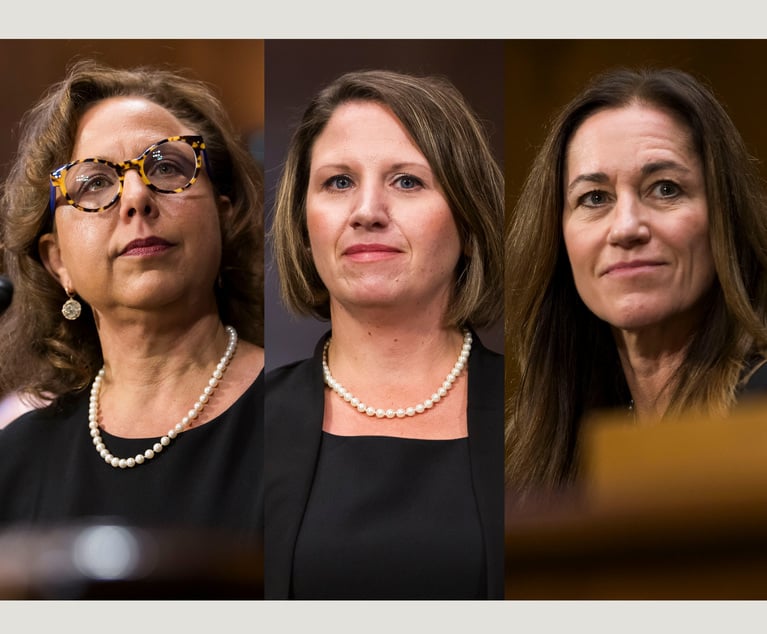Guidance for Voluntary Cleanups and Preserving Potential Contribution Rights
The benefits of cleaning up and reusing contaminated properties are difficult to overstate—these voluntary cleanups promote reuse of existing infrastructure, protect human health, provide economic benefits to the surrounding area and assist in the preservation of undeveloped green spaces.
November 14, 2019 at 12:54 PM
6 minute read
 Kaitlyn Maxwell of Greenberg Traurig
Kaitlyn Maxwell of Greenberg Traurig
State voluntary cleanup programs have facilitated the cleanup and reuse of contaminated commercial and industrial properties throughout the country. The benefits of cleaning up and reusing contaminated properties are difficult to overstate—these voluntary cleanups promote reuse of existing infrastructure, protect human health, provide economic benefits to the surrounding area and assist in the preservation of undeveloped green spaces. Pennsylvania environmental lawyers frequently advise clients on voluntary cleanups under the land recycling program (Act 2). A party voluntarily cleaning up a property likely should consider at the onset whether the party intends to seek contribution from potentially responsible parties for the cleanup costs. In the U.S. Court of Appeals for the Third Circuit, there is a question whether a party completing a voluntary cleanup must take steps beyond the actions required by the state program in order to seek contribution from potentially responsible parties under the Comprehensive Environmental Response, Compensation, and Liability Act, 42 U.S.C. Section 9601 et seq (CERCLA). When in doubt, parties may wish to take steps to comply with the requirements of CERCLA.
CERCLA provides that a private party seeking to recover costs under CERCLA must establish the costs were incurred consistent with the national contingency plan (NCP), 42 U.S.C. Section 9607(a)(4)(B). The Third Circuit has largely followed this NCP consistency requirement for private party contribution actions, even for a party who resolved its liability to the United States or a state pursuant to an administrative or judicially approved settlement, see 42 U.SC. Section 9613(f)(3)(B). The NCP sets forth a rigorous process for remedy selection.
State voluntary cleanup programs like Act 2 seek to reduce some of the burdens imposed on parties conducting remediation to encourage voluntary cleanups. For example, under the NCP, a remedial action—a permanent cleanup—requires a remedial investigation to assess site conditions and then a feasibility study to evaluate alternative remedial actions, 40 C.F.R. Section 300.430. The NCP sets forth nine criteria for evaluation of the alternatives, including consideration of protectiveness and compliance with federal and state environmental laws as well as the ability to implement, cost and state acceptance, among other factors. The public must be provided the opportunity to comment on the selected remedy. Then the U.S. Environmental Protection Agency (EPA) must identify the selected remedy in a record of decision (ROD). This is a time-intensive and costly process.
In comparison, Act 2 establishes the remedial action objectives—cleanup standards. Although the initial notice of intent to remediate is published, there is no further required public participation unless the cleanup standard is site-specific. Looking at these voluntary steps in the abstract, complying with Act 2 standards may not necessarily assure consistency with the NCP. Voluntary cleanup programs are intended to reduce the burdens on the remediating party while ensuring protectiveness of human health and the environment. Cleanup standards like those established under Act 2 provide for predictability and promote the reuse of properties that may otherwise remain stagnant and contaminated due to the unknown liability risks.
The EPA and the Pennsylvania Department of Environmental Protection (PADEP) entered into the one cleanup memorandum to facilitate the DEP's implementation of Act 2, confirming that Act 2 meets the requirements of a state response program pursuant to Section 128(a)(2) of CERCLA. There will only be one cleanup. Because compliance with Act 2 implicates the enforcement bar of Section 128, there is an argument that compliance with Act 2 resolves a party's liability to the United States, thereby providing that party with a right of action in contribution pursuant to Section 113(f)(3)(B) of CERCLA. Section 128 of CERCLA does not expressly require a voluntary remediator to comply with the NCP. One could argue that the statute's silence means Section 113(f)(3)(B) allows for a voluntary remediator to seek contribution from potentially responsible parties even if the cleanup party's costs were not incurred consistent with the NCP. The Third Circuit's decision in Trinity Industries v. Greenlease Holdings, 903 F.3d 333 (3d Cir. 2018), may support that reading.
In Trinity Industries, the court held that a party's response costs incurred under a Pennsylvania Hazardous Sites Clean Up Act (HSCA) consent decree were consistent with the NCP and recoverable under Section 113(f)(3)(B) of CERCLA because the costs were incurred in compliance with Act 2 and under the supervision of the PADEP. The court declined to address whether response costs undertaken in compliance with a state consent decree were presumed reasonable, but the court noted that "similar costs incurred by a government party are presumed reasonable." Notably, a government party's costs are presumed consistent with the NCP absent a showing by a responsible party that the costs are inconsistent. In contrast, a private party seeking recovery bears the burden of proving consistency. Footnote 13 suggests the court may be willing to find that compliance with a state consent decree is enough under CERCLA to entitle a party to a contribution action. Prior decisions in the Third Circuit, however, have suggested that even a voluntary cleanup party must comply with the NCP.
Do the Third Circuit's findings in Trinity Industries suggest a departure from strict adherence to the requirements of the NCP for voluntary cleanups? Although some may argue this decision should be applied broadly to mean the PADEP supervision and compliance with Act 2 satisfies the NCP, others may contend Act 2 compliance is merely a substitute. As a practical matter, until the Third Circuit provides further clarification, lawyers advising clients on voluntary cleanups should flag the potential risk that cleanup costs may not be recoverable—even if conducted pursuant to PADEP supervision under Act 2—unless the client can prove the costs were consistent with the NCP. For those clients who do not intend to seek contribution, compliance with the state program is likely enough. After all, there are many factors that motivate voluntary cleanup, which are not dependent on any potential future contribution claim. But, for those clients who want to reserve this potential contribution right, additional steps should be taken to ensure consistency with the NCP throughout the voluntary cleanup.
Kaitlyn R. Maxwell practices in the environmental group of Greenberg Traurig, with a focus on environmental litigation. Contact her at [email protected] .
This content has been archived. It is available through our partners, LexisNexis® and Bloomberg Law.
To view this content, please continue to their sites.
Not a Lexis Subscriber?
Subscribe Now
Not a Bloomberg Law Subscriber?
Subscribe Now
NOT FOR REPRINT
© 2025 ALM Global, LLC, All Rights Reserved. Request academic re-use from www.copyright.com. All other uses, submit a request to [email protected]. For more information visit Asset & Logo Licensing.
You Might Like
View All
Pa. Federal District Courts Reach Full Complement Following Latest Confirmation

The Defense Bar Is Feeling the Strain: Busy Med Mal Trial Schedules Might Be Phila.'s 'New Normal'
7 minute read
Federal Judge Allows Elderly Woman's Consumer Protection Suit to Proceed Against Citizens Bank
5 minute read
Judge Leaves Statute of Limitations Question in Injury Crash Suit for a Jury
4 minute readLaw Firms Mentioned
Trending Stories
- 1We the People?
- 2New York-Based Skadden Team Joins White & Case Group in Mexico City for Citigroup Demerger
- 3No Two Wildfires Alike: Lawyers Take Different Legal Strategies in California
- 4Poop-Themed Dog Toy OK as Parody, but Still Tarnished Jack Daniel’s Brand, Court Says
- 5Meet the New President of NY's Association of Trial Court Jurists
Who Got The Work
J. Brugh Lower of Gibbons has entered an appearance for industrial equipment supplier Devco Corporation in a pending trademark infringement lawsuit. The suit, accusing the defendant of selling knock-off Graco products, was filed Dec. 18 in New Jersey District Court by Rivkin Radler on behalf of Graco Inc. and Graco Minnesota. The case, assigned to U.S. District Judge Zahid N. Quraishi, is 3:24-cv-11294, Graco Inc. et al v. Devco Corporation.
Who Got The Work
Rebecca Maller-Stein and Kent A. Yalowitz of Arnold & Porter Kaye Scholer have entered their appearances for Hanaco Venture Capital and its executives, Lior Prosor and David Frankel, in a pending securities lawsuit. The action, filed on Dec. 24 in New York Southern District Court by Zell, Aron & Co. on behalf of Goldeneye Advisors, accuses the defendants of negligently and fraudulently managing the plaintiff's $1 million investment. The case, assigned to U.S. District Judge Vernon S. Broderick, is 1:24-cv-09918, Goldeneye Advisors, LLC v. Hanaco Venture Capital, Ltd. et al.
Who Got The Work
Attorneys from A&O Shearman has stepped in as defense counsel for Toronto-Dominion Bank and other defendants in a pending securities class action. The suit, filed Dec. 11 in New York Southern District Court by Bleichmar Fonti & Auld, accuses the defendants of concealing the bank's 'pervasive' deficiencies in regards to its compliance with the Bank Secrecy Act and the quality of its anti-money laundering controls. The case, assigned to U.S. District Judge Arun Subramanian, is 1:24-cv-09445, Gonzalez v. The Toronto-Dominion Bank et al.
Who Got The Work
Crown Castle International, a Pennsylvania company providing shared communications infrastructure, has turned to Luke D. Wolf of Gordon Rees Scully Mansukhani to fend off a pending breach-of-contract lawsuit. The court action, filed Nov. 25 in Michigan Eastern District Court by Hooper Hathaway PC on behalf of The Town Residences LLC, accuses Crown Castle of failing to transfer approximately $30,000 in utility payments from T-Mobile in breach of a roof-top lease and assignment agreement. The case, assigned to U.S. District Judge Susan K. Declercq, is 2:24-cv-13131, The Town Residences LLC v. T-Mobile US, Inc. et al.
Who Got The Work
Wilfred P. Coronato and Daniel M. Schwartz of McCarter & English have stepped in as defense counsel to Electrolux Home Products Inc. in a pending product liability lawsuit. The court action, filed Nov. 26 in New York Eastern District Court by Poulos Lopiccolo PC and Nagel Rice LLP on behalf of David Stern, alleges that the defendant's refrigerators’ drawers and shelving repeatedly break and fall apart within months after purchase. The case, assigned to U.S. District Judge Joan M. Azrack, is 2:24-cv-08204, Stern v. Electrolux Home Products, Inc.
Featured Firms
Law Offices of Gary Martin Hays & Associates, P.C.
(470) 294-1674
Law Offices of Mark E. Salomone
(857) 444-6468
Smith & Hassler
(713) 739-1250





